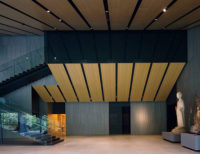Nothing says elegance like a classic Tiffany diamond. And nothing evokes a Tiffany diamond (in architectural language) like the facade of the jeweler’s flagship store in the heart of Tokyo. The creation of architect Kengo Kuma, this shimmering, faceted wall of aluminum honeycomb and high-transparency glass reflects street activity during the day but turns into a dazzling light show when the sun goes down.
Prominently located on a broad boulevard in Ginza, the city’s high-end shopping district, the new store fills the base of an aging, nine-story office building acquired by the New York retailer for its Tokyo headquarters. “We wanted this building to visually represent Tiffany in Japan,” explains Michael Crist, president of Tiffany & Co., Japan. Adding fresh sparkle and luster to the tarnished structure, Kuma’s proposal for a new facade plus an interior renovation won the heart of Tiffany’s competition jury.
Both client and architect wanted to front the street with a uniform elevation, though the store itself only occupies the bottom three floors of the building. The first level targets the young, trendy shopper, the second aims at the big spender, and the third hosts a customer-service area in addition to a salon. Tenant office space occupies the remaining floors above. Inspired by Tiffany’s signature diamond setting, in which the cut stone is lifted from the ring allowing light to reach it from multiple directions, Kuma covered the entire wall with individual square panels, all 292 of them canted at various angles and mounted separately with steel prongs. “We treated each panel as an independent architectural piece,” says Kuma.
Composed of two layers of honeycomb, an aluminum material normally hidden inside airplane wings but here laminated between glass sheets and secured by steel frames, every panel is illuminated from behind by a row of LED pinpoint luminaires. Lining the base of each panel, these lights were chosen not just for their compact size and long lamp life but also because of their welcoming, warm white color of 3000 Kelvin. Up close, the metal screens emit a brilliant glow, but from afar, the building’s broken surface makes a different statement, especially at night when the tiny lights go on and off in a smooth, undulating sequence. “We wanted to create an optical effect with the character of breathing,” explains the facade’s lighting designer, Satoshi Uchihara.
But the bling does not stop at the front door. Unlike most Tiffany shops around the world, this one opens with a dramatic, double-height entrance foyer that binds the two sales floors together. Visible from the outside but spectacular on the inside, the atrium’s back wall of golden stone acts as the showpiece of this well-appointed store. Sourced and sliced in Italy before shipment to Japan, the 0.16-inch-thick stone panels are glued to sheets of high-transparency glass in front and supported by 0.39-inch-thick glass slabs in back. Lit from behind by ceramic-metal-halide lamps enclosed within reflective panels, the luminous wall with its crystalline pattern is a mesmerizing sight that complements the jewels displayed in its recessed niches.
Within the shop, Kuma had to choose space-saving luminaires, such as LED tape, that could accommodate dropped beams and other building constraints, plus he had to incorporate the company’s standard lighting solutions: halogen lamps to spotlight the merchandise, LEDs within the showcases, and fluorescent fixtures for ambient lighting. Nonetheless, a magnificent, Kuma-designed chandelier crowns the stairway that connects the second and third floors. Composed of 27 rectangular panels of acrylic-covered aluminum honeycomb — each one outlined with an LED pinpoint strip — the fixture echoes the materiality and twinkle of the eye-catching facade.
Combining luminescence and transparency, Kuma’s scheme is a decidedly new direction for the venerated brand famous for its vaultlike exterior wall and shuttered steel doors. It is a strategy that firmly establishes Tiffany’s presence in Ginza without severing the tie to Fifth Avenue.





Post a comment to this article
Report Abusive Comment